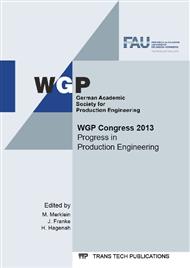[1]
W. Farren, G. Taylor: Heat development during plastic extension of metals; in: Proceedings of the Royal Society of London A, 5 (1925), p.422–451
Google Scholar
[2]
G. Taylor, H. Quinney: The latent energy remaining after cold working; in: Proceedings of the Royal Society of London A (1934), p.307–326
Google Scholar
[3]
J. Talonen: Energetics of Plastic Deformation of Metastable Austenitic Stainless Steel; in: steel research international, 78 (2007), Heft 3, p.260–265
DOI: 10.1002/srin.200705889
Google Scholar
[4]
A. Hänsel: Nichtisothermes Werkstoffmodell für FE-Simulation von Blechumformprozessen mit metastabilen austenitischen CrNi-Stählen; Dissertation, ETH Zürich, (1998)
Google Scholar
[5]
R. Steinheimer, B. Engel: Influence of disipating energy on flow curves of austenitic stainless steel; in: The 8th International Conference and Workshop on Numerical Simulation of 3D Sheet Metal Forming Processes, p.709–716, Seoul, (2011)
DOI: 10.1063/1.3623676
Google Scholar
[6]
R. Grueebler, P. Hora: Temperature dependent friction modeling for sheet metal forming; in: International Journal of Material Forming, 2 (2009), Heft S1, p.251–254
DOI: 10.1007/s12289-009-0548-z
Google Scholar
[7]
J. Schulz, W. Holweger: Wechselwirkung von Additiven mit Metaloberflächen, Spinger-Verlag, Berlin Heidelberg New York, 2010, ISBN 978-3-8169-2921-5
Google Scholar
[8]
M. Wünsch: Möglichkeiten und Grenzen von Schmierstoffen, Lüdenscheid, (2004)
Google Scholar
[9]
T. Angel: Formation of martensite in austenitic stainless steel; in: Journal of the iron and steel institute, May (1954), p.165–174
Google Scholar
[10]
G. Olsen; Cohen, M.: Kinetics of Strain-Induced Martensitic Nucleation; in: Metallurgical transaction A, Volume 6A (1975)
Google Scholar
[11]
T. Byun; Hashimoto, N., et al.: Temperature dependence of strain hardening and plastic instability behaviors in austenitic stainless steels; in: Acta Materialia, 52 (2004) (2004), p.3889
DOI: 10.1016/j.actamat.2004.05.003
Google Scholar
[12]
A. Frehn: Einfluss der Umformgeschwindigkeit und Temperatur auf das Verhalten von nichtrostenden, austentischen Stählen; Dissertation, RWTH Aachen, (2004)
Google Scholar
[13]
H. Hallberg; Hakansson, P., et al.: A Constitutive Model for the Formation of Martensite in Austenitic Steels Under Large Strain Plasticity; in: International Journal of Plasticity, 2007 (2007), Heft 23(7), p.1213–1239
DOI: 10.1016/j.ijplas.2006.11.002
Google Scholar
[14]
S. Galée; P. Pilvin: Deep drawing simulation of a metastable austenitic stainless steel using a two-phase model; in: Journal of materials processing technology, 210 (2010), p.835–843
DOI: 10.1016/j.jmatprotec.2010.01.008
Google Scholar
[15]
B. Springub: Semi-analytische Betrachtung des Tiefziehens rotationssysmmetrischer Bauteile unter Berücksichtigung der Martensitevolution; Dissertation, Universität Hannover, (2006)
Google Scholar
[16]
E. Schedin, J. Kajberg: Real behavior and FEA modeling of stainless steels; in: Proceedings of the FLC, Zurich 2006 (2006)
Google Scholar
[17]
C. Tague; C. Martin: Sheet Formability and Performance of Metastable Austenitic Stainless Steels; in: steel research international, 79 (2008), Heft 6, p.423–432
DOI: 10.1002/srin.200806148
Google Scholar
[18]
J. Krauer, P. Hora, et al.: Forming Limit Prediction of Metastable Materials with Temperature and Strain Induced Martensite Transformation; in: IDDRG 09, 2009 (2009)
DOI: 10.1063/1.2740983
Google Scholar
[19]
S. Kulp: Herstellung von Blechformteilen aus Reintitanwerkstoffen und hochlegierten rostfreien Stählen; Dissertation, Uni Hannover, (2003)
Google Scholar
[20]
A. Korhonen; Manninen, T., et al.: Forming and fracture limits of two metastable high strngth austenitic stainless steels; in: steel research international, special edition (2011), p.1084–1089
Google Scholar
[21]
P. Groche; M. Engels: Analyse und Beeinflussung des Wärmehaushalts in der Aluminiumumformung; EFB-Bericht, Heft Nr. 337, (2011)
Google Scholar
[22]
B. Hochholdinger; P. Hora, et al.: Simulation of the Press Hardening Process and Prediction of the Final Mechanical Material Properties; in: The 8th International Conference and Workshop on Numerical Simulation of 3D Sheet Metal Forming Processes, p.618–625, Seoul, (2011)
DOI: 10.1063/1.3623665
Google Scholar
[23]
R. Abelson; M. Abdou: Experimental evaluation of the interface heat conductance between roughened beryllium and stainless steel surfaces; in: Journal of Nuclear Material (1996), p.847–851
DOI: 10.1016/s0022-3115(96)00241-3
Google Scholar
[24]
M. Rosochowska; K. Chodnikiewicz, et al.: A new method of measuring thermal contact conductance; in: Journal of materials processing technology (2004), Heft 145, p.207–214
DOI: 10.1016/s0924-0136(03)00671-x
Google Scholar
[25]
M. Alasti: Modellierung von Reibung und Wärmeübergängen in der FEM-Simulation von Warmmassivumformprozessen; Dissertation, Universität Hannover, (2008)
Google Scholar
[26]
J.-H. Kerspe: Abstreckgleitziehen von nichtrostenden austenitischen Stählen; Dissertation, IFU, Universität Stuttgart, (1980)
DOI: 10.1007/978-3-642-52208-6
Google Scholar
[27]
P. Schmid, M. Liewald: Determination of temperature dependent forming limit curves of metastable austenitic stainless steel considering martensite formation; ESS Conference, Como, (2011)
DOI: 10.1063/1.3623643
Google Scholar
[28]
P. Schmid, M. Liewald.: New Developments in Sheet Metal Forming of Stainless Steel - Current Investigations and Future Challenges; in: Proceedings of the NAMRII/SME, 40, (2012)
Google Scholar
[29]
B.B. Mikic (1966): Thermal Contact Resistance, Dissertation, Massachusetts Institute of Technology, (1966)
Google Scholar


